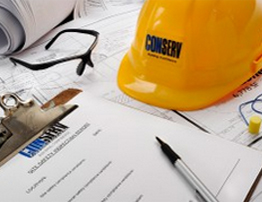Subfloor / Underhouse Areas
The areas listed below have been identified over the years from research and experience and while designed to assist property owners with their termite management, the following list may not be altogether conclusive and some items of course may not apply to all properties.
- Inadequate ventilation in subfloor areas. Termites are known to favour areas that provide damp conditions and those which offer a lack of ventilation for any timbers with inadequate space allowing for crossflow of the air. All timbers and service should have a minimum of 400 mm clearance between the lowest point in the structure and ground level.
- Inadequate ant capping in place. In older properties, usually of the post-war vintage, which have slightly elevated subfloors it is very common to have a combination of both inadequate ventilation and a poor standard of ant capping in place. In many cases the ends of bearers and joists are on top of these masonry walls, or embedded in them, and there is an extremely inadequate, corroded, not aligned and in many cases non-existent level of ant capping in place. Another common opportunity for termites is where masonry block walls are used for structural components of an under house and they are not core filled. The hollow blocks provide an excellent concealment for termites to make their way from the ground to the top level of the property and an undetected manner. Termites are known to use both these varieties of walls to access the upper levels of properties. There are other areas where inadequate ant capping and practices are carried out in one of these we encounter quite often, which creates an extremely high termite risk, is where concrete stumps are embedded in cladding and walls and in some cases concealed entirely by the linings creating an extreme risk for concealed termite entry.
- Damp or wet timbers. As in the case with the ventilation, it is also known that termites seek out and favour conditions that are conducive to dampness and/or moisture leakages from any wet areas. Because of this all property owners should ensure that there is a vigilant monitoring of all flooring areas within subfloors beneath the wet areas above, as if there were any leakages this would obviously provide an attraction to any foraging termites within the area. The other area where timbers can be exposed to damp conditions and deteriorate is at the edges of the structure particularly for timber and tin or Queenslander type structures where windblown rain can often have a significant effect on timbers within the veranda or decking areas, softening and weakening them, again making them attractive for termites.
- Damp soil on ground/inadequate drainage. Termites are known to favour areas that provide dampness and areas where moisture is prevalent, as it is very conducive and productive for their survival. In fact, they require it for the of the nest colony. There can be many influences on moisture being created in subfloor areas and some of these include adequate drainage being in place, stormwater materials not being connected to drainage outlets, air conditioning condenser units having outlets not plumbed to stormwater drainage points, having roofing materials without gutters and downpipes, corroding roofing materials and contours of land aiming towards structure etc. At all times it is essential that the collection of moisture be eliminated either near the structure or within the subfloor areas, and obviously and critically for lower-level developed areas of the interior.
- Timbers in contact with subfloor soil. There are many occasions where we carry out inspections and timbers are identified in subfloor/under house areas that are in direct contact with the ground therefore providing any termites in the area, which are a subterranean insect, direct and concealed access to these timbers and potentially the upper levels of the structure. Examples of timbers we often come across that fall into this scenario are plates that are adhered between concrete stumps (that support other timbers for the decorative palings between the stumps), vertical paling timbers between the isolated piers, timber stump isolated piers, timber posts, framing timbers and exterior cladding material. All timbers should have a minimum clearance of 150 mm at their base from ground contact, unless they are a class I durable hardwood as these are known to be strong enough to resist decay and termite activity e.g. Ironbark
- Engaged piers. During our inspections of the subfloor areas a very common area of the subfloor that termites seem to favour building their mud tubes towards the structure above is the intersecting wall and the engaged piers that are part of the footing system. The science on this is unknown however over the 15 years we have been carrying out timber pest inspections this has been a very common area where we have identified termite tubes. If there is inadequate or no and capping atop the brick walls then obviously the risk of termites seeking access to the structure, particularly if there is no treated zone in place within the soil at the foot of the brick walls, is very high. If that is the case for subject residence, then you should consider it absolutely critical to maintain at all times a Treated Zone in all areas of the subfloor to impede termites obtaining access into the structure.
- Previously treated but subsequently disturbed ground. Where chemical Treated Zones have been installed it is essential for the effectiveness of the treatment to ensure that it is not breached or disturbed in any way for the entire duration of the life span for the treatment. Any digging, excessive moisture exposure and generally anything that could cause a disturbance to the Treated Zone should be avoided at all times, as should the placing of any materials or furniture/storage items against the structure, as this would provide a bridging opportunity for termites to bypass the treated soil and gain access to the structure.
White ants forage in the ground all over the region looking for food and are not territorial. They emerge and return to ground seeking their food source. If any of the items listed above apply to this property, present or future, then the chances of discovering white ants at some stage should not be regarded as unusual.








 All too often during our inspections we identify areas which are conducive to the collection of retained ground moisture near a structure. Elevated moisture levels are known to provide conditions favourable to Timber Pest activity, particularly termites, and it is vital that every effort be made to avoid these risks. The most common causes of retained ground moisture are inadequate surface water drainage, downpipes not connected to drainage outlets, no gutters in place for roofing areas, outlet pipes for air conditioners, relief and overflow valves for hot water cylinders, corroding and join leakages of gutters and downpipes, defective or incomplete flashing and plumbing for rainwater tanks leaking. These are all issues which can be, and should be rectified, if they are in existence at a property.
All too often during our inspections we identify areas which are conducive to the collection of retained ground moisture near a structure. Elevated moisture levels are known to provide conditions favourable to Timber Pest activity, particularly termites, and it is vital that every effort be made to avoid these risks. The most common causes of retained ground moisture are inadequate surface water drainage, downpipes not connected to drainage outlets, no gutters in place for roofing areas, outlet pipes for air conditioners, relief and overflow valves for hot water cylinders, corroding and join leakages of gutters and downpipes, defective or incomplete flashing and plumbing for rainwater tanks leaking. These are all issues which can be, and should be rectified, if they are in existence at a property.






